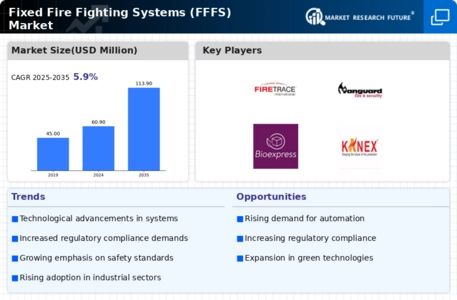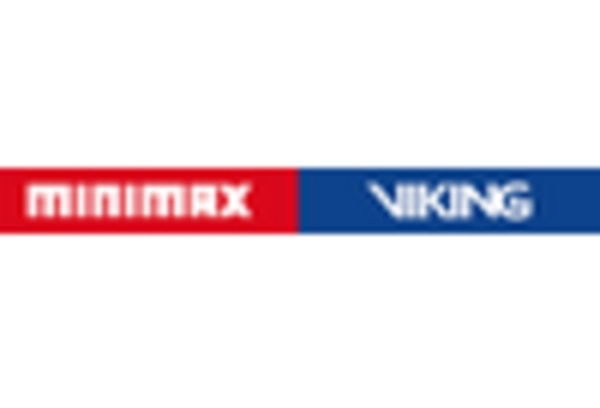-
GLOBAL FIXED FIRE FIGHTING SYSTEMS (FFFS) MARKET, BY PRODUCT
-
GLOBAL
-
FIXED FIRE FIGHTING SYSTEMS (FFFS) MARKET, BY APPLICATION 17
-
BY REGION 18
-
MARKET INTRODUCTION 19
-
DEFINITION 19
-
SCOPE OF THE STUDY 19
-
MARKET STRUCTURE 20
-
KEY IMPLEMENTATION CRITERIA 20
-
GLOBAL FIXED FIRE FIGHTING SYSTEMS (FFFS) MARKET,
-
RESEARCH METHODOLOGY 21
-
MARKET DYNAMICS 28
-
INTRODUCTION 28
-
DRIVERS 28
- INCREASING IMPLEMENTATION OF FFFS ACROSS TUNNEL
-
CONSTRUCTIONS 28
-
RISING USE OF FFFS SOLUTIONS ACROSS OFFSHORE & ONSHORE APPLICATIONS 29
-
RESTRAINTS 29
- FIXED FIRE FIGHTING
-
SYSTEMS HAVING SIGNIFICANT CAPITAL OUTLAY 29
-
OPPORTUNITIES 30
- ADVANCED DETECTION SYSTEMS AND TECHNOLOGY INTEGRATION
- INCREASING
-
USE OF WATER MIST SYSTEMS FOR SUPPRESSING FIRES 30
-
IMPACT OF COVID-19 ON FIXED FIRE FIGHTING SYSTEMS
- IMPACT ON INDUSTRY VERTICALS 32
-
(FFFS) MARKET 31
-
IMPACT ON TECHNOLOGY 31
-
MARKET FACTOR ANALYSIS 33
-
SUPPLY/VALUE CHAIN ANALYSIS 33
-
PORTER FIVE FORCES 34
-
GLOBAL FIXED FIRE FIGHTING
-
SYSTEMS (FFFS) MARKET, BY PRODUCTS 35
-
INTRODUCTION 35
-
HARDWARE 37
- FIRE SPRAY NOZZLES 39
- FOAM FIREFIGHTING SYSTEMS 40
- NON-WATER BASED FIRE SUPPRESSION
- FIREFIGHTING MONITORS 43
- KITCHEN FIRE SUPPRESSION SYSTEMS 45
- WATER HOSE REELS
- RISERS
- SPRINKLER
-
SYSTEMS 41
-
DELUGE VALVE SYSTEMS 43
-
SYSTEMS 48
-
WATER MIST SYSTEMS 49
-
ACCESSORIES 50
-
SOFTWARE 50
-
SERVICES 51
-
GLOBAL FIXED FIRE FIGHTING SYSTEMS (FFFS) MARKET, BY APPLICATION 53
-
INTRODUCTION 53
-
CHEMICAL PLANTS 56
-
INDUSTRIAL ENVIRONMENTS
-
TUNNELS
-
MARINE
-
& INLAND SHIPPING 57
-
SHORE ACTIVITIES 58
-
RESIDENTIAL HOMES 58
-
COMMERCIAL BUILDINGS 58
-
OTHER APPLICATIONS 59
-
GLOBAL FIXED FIRE FIGHTING SYSTEMS (FFFS) MARKET,
-
BY REGION 60
-
OVERVIEW 60
-
NORTH AMERICA 62
-
U.S. 65
-
CANADA 66
-
MEXICO 68
-
EUROPE 71
-
GERMANY 73
-
U.K. 75
-
FRANCE 77
-
SPAIN 79
-
REST OF EUROPE 81
-
ASIA-PACIFIC 84
-
CHINA 87
-
INDIA 89
-
JAPAN 91
-
SOUTH KOREA 92
-
AUSTRALIA 94
-
REST OF APAC 96
-
MEA 99
-
GCC COUNTRIES 101
-
SOUTH AFRICA 103
-
ROMEA 105
-
LATIN AMERICA 108
-
BRAZIL 110
-
ARGENTINA 112
-
ROLA 114
-
COMPETITIVE LANDSCAPE 117
-
MARKET SHARE ANALYSIS 117
-
COMPETITIVE BENCHMARKING 118
-
RECENT DEVELOPMENTS 119
- BUSINESS EXPANSION/
-
CAPABILITY EXPANSION/ EQUITY INVESTMENT 119
-
COMPANY PROFILES 120
-
CISCO SYSTEMS, INC 120
- COMPANY OVERVIEW 120
- FINANCIAL OVERVIEW 121
- PRODUCTS AND SERVICES 121
- SWOT ANALYSIS 122
- KEY STRATEGIES
-
HONEYWELL
- KEY DEVELOPMENTS 125
- SWOT ANALYSIS 126
- KEY STRATEGIES 126
-
INTERNATIONAL INC. 123
-
COMPANY OVERVIEW 123
-
FINANCIAL OVERVIEW 124
-
PRODUCTS AND SERVICES 124
-
FIRE SHIELD SYSTEMS LIMITED 127
- COMPANY OVERVIEW 127
- FINANCIAL OVERVIEW
- FIRE SHIELD SYSTEMS LIMITED: SWOT ANALYSIS 128
- KEY STRATEGIES 128
-
PRODUCTS AND SERVICES 127
-
DRAGERWERK AG &
- DRAGERWERK AG & CO. KGAA: SWOT ANALYSIS 131
- KEY STRATEGIES 131
-
CO. KGAA 129
-
COMPANY OVERVIEW 129
-
FINANCIAL OVERVIEW 129
-
PRODUCTS AND SERVICES 130
-
VIGIL PRODUCTS 132
- COMPANY OVERVIEW
- VIGIL PRODUCTS: SWOT ANALYSIS 133
- KEY STRATEGIES 133
-
FINANCIAL OVERVIEW 132
-
PRODUCTS AND SERVICES 132
-
BIO EX 134
- COMPANY OVERVIEW 134
- FINANCIAL OVERVIEW 134
- PRODUCTS AND SERVICES 134
- KANEX: KEY DEVELOPMENTS
- SWOT ANALYSIS 137
- KEY STRATEGIES 137
-
SWOT ANALYSIS 135
-
KEY STRATEGIES 135
-
KANEX FIRE. 136
-
COMPANY OVERVIEW 136
-
FINANCIAL OVERVIEW 136
-
PRODUCTS AND SERVICES 136
-
FIRETRACE 139
- COMPANY OVERVIEW 139
- FINANCIAL OVERVIEW 139
- PRODUCTS AND SERVICES 139
- SWOT ANALYSIS 140
- KEY STRATEGIES
-
VANGUARD
- SWOT ANALYSIS 143
- KEY STRATEGIES 143
-
FIRE 142
-
COMPANY OVERVIEW 142
-
FINANCIAL OVERVIEW 142
-
PRODUCTS AND SERVICES 142
-
REACTION FIRE SUPPRESSION LIMITED 144
- COMPANY OVERVIEW
- SWOT ANALYSIS 145
- KEY STRATEGIES 145
-
FINANCIAL OVERVIEW 144
-
PRODUCTS AND SERVICES 144
-
-
LIST OF TABLES
-
GLOBAL FIXED FIRE FIGHTING SYSTEMS (FFFS) MARKET,
-
BY PRODUCT, 2019–2032 (USD MILLION) 35
-
GLOBAL FIXED FIRE FIGHTING SYSTEMS (FFFS)
-
HARDWARE MARKET, BY REGION, 2019–2032 (USD MILLION) 37
-
GLOBAL FIXED FIRE FIGHTING SYSTEMS (FFFS)
-
HARDWARE MARKET, BY TYPE, 2019–2032 (USD MILLION) 38
-
GLOBAL FIXED FIRE FIGHTING SYSTEMS (FFFS)
-
HARDWARE MARKET, FOR FIRE SPRAY NOZZLES, BY REGION, 2019–2032 (USD MILLION)
-
TABLE 5
-
GLOBAL FIXED FIRE FIGHTING SYSTEMS (FFFS) HARDWARE MARKET, FOR FOAM FIREFIGHTING
-
SYSTEMS, BY REGION, 2019–2032 (USD MILLION) 40
-
GLOBAL FIXED FIRE FIGHTING SYSTEMS (FFFS)
-
HARDWARE MARKET, FOR NON-WATER BASED FIRE SUPPRESSION SYSTEMS, BY TYPE, 2019–2032
-
(USD MILLION) 41
-
TABLE
-
GLOBAL FIXED FIRE FIGHTING SYSTEMS (FFFS) HARDWARE MARKET, FOR NON-WATER BASED
-
FIRE SUPPRESSION SYSTEMS, BY REGION, 2019–2032 (USD MILLION) 42
-
GLOBAL FIXED
-
FIRE FIGHTING SYSTEMS (FFFS) HARDWARE MARKET, FOR DELUGE VALVE SYSTEMS, BY REGION,
-
GLOBAL FIXED FIRE FIGHTING SYSTEMS (FFFS) HARDWARE MARKET,
-
FOR FIREFIGHTING MONITORS, BY TYPE, 2019–2032 (USD MILLION) 44
-
GLOBAL FIXED FIRE FIGHTING
-
SYSTEMS (FFFS) HARDWARE MARKET, FOR FIREFIGHTING MONITORS, BY REGION, 2019–2032
-
(USD MILLION) 45
-
TABLE
-
GLOBAL FIXED FIRE FIGHTING SYSTEMS (FFFS) HARDWARE MARKET, FOR KITCHEN FIRE SUPPRESSION
-
SYSTEMS, BY REGION, 2019–2032 (USD MILLION) 46
-
GLOBAL FIXED FIRE FIGHTING SYSTEMS (FFFS)
-
HARDWARE MARKET, FOR WATER HOSE REELS, BY TYPES,
-
GLOBAL FIXED FIRE FIGHTING
-
SYSTEMS (FFFS) HARDWARE MARKET, FOR WATER HOSE REELS, BY REGION, 2019–2032
-
(USD MILLION) 47
-
TABLE
-
GLOBAL FIXED FIRE FIGHTING SYSTEMS (FFFS) HARDWARE MARKET, FOR RISERS, BY TYPE,
-
GLOBAL FIXED FIRE FIGHTING SYSTEMS (FFFS) HARDWARE MARKET,
-
FOR RISERS, BY REGION, 2019–2032 (USD MILLION) 48
-
GLOBAL FIXED FIRE FIGHTING SYSTEMS (FFFS)
-
HARDWARE MARKET, FOR SPRINKLER SYSTEMS, BY REGION, 2019–2032 (USD MILLION)
-
TABLE 17
-
GLOBAL FIXED FIRE FIGHTING SYSTEMS (FFFS) HARDWARE MARKET, FOR WATER MIST SYSTEMS,
-
BY REGION, 2019–2032 (USD MILLION) 49
-
GLOBAL FIXED FIRE FIGHTING SYSTEMS (FFFS)
-
HARDWARE MARKET, FOR ACCESSORIES, BY REGION,
-
GLOBAL FIXED FIRE FIGHTING
-
SYSTEMS (FFFS) SOFTWARE MARKET, BY REGION, 2019–2032 (USD MILLION) 51
-
GLOBAL FIXED
-
FIRE FIGHTING SYSTEMS (FFFS) SERVICES MARKET, BY TYPE, 2019–2032 (USD MILLION)
-
TABLE 21
-
GLOBAL FIXED FIRE FIGHTING SYSTEMS (FFFS) SERVICES MARKET, BY REGION, 2019–2032
-
(USD MILLION) 52
-
TABLE
-
GLOBAL FIXED FIRE FIGHTING SYSTEMS (FFFS) MARKET, BY APPLICATION, 2019–2032
-
(USD MILLION) 53
-
TABLE
-
GLOBAL FIXED FIRE FIGHTING SYSTEMS (FFFS) MARKET, FOR CHEMICAL PLANTS, BY REGION,
-
GLOBAL FIXED FIRE FIGHTING SYSTEMS (FFFS) MARKET, BY INDUSTRIAL
-
ENVIRONMENTS, BY REGION,
-
GLOBAL FIXED FIRE FIGHTING SYSTEMS (FFFS)
-
MARKET, BY TUNNELS, BY REGION, 2019–2032 (USD MILLION) 57
-
GLOBAL FIXED FIRE FIGHTING
-
SYSTEMS (FFFS) MARKET, BY MARINE & INLAND SHIPPING, BY REGION,
-
TABLE 27
-
GLOBAL FIXED FIRE FIGHTING SYSTEMS (FFFS) MARKET, BY SHORE ACTIVITIES, BY REGION,
-
GLOBAL FIXED FIRE FIGHTING SYSTEMS (FFFS) MARKET, BY RESIDENTIAL
-
HOMES, BY REGION, 2019–2032 (USD MILLION) 58
-
GLOBAL FIXED FIRE FIGHTING SYSTEMS (FFFS)
-
MARKET, BY COMMERCIAL BUILDINGS, BY REGION, 2019–2032 (USD MILLION) 58
-
GLOBAL FIXED
-
FIRE FIGHTING SYSTEMS (FFFS) MARKET, BY OTHER APPLICATIONS, BY REGION, 2019–2032
-
(USD MILLION) 59
-
TABLE
-
GLOBAL FIXED FIRE FIGHTING SYSTEMS (FFFS) MARKET, BY REGION, 2019–2032
-
(USD MILLION) 61
-
TABLE
-
NORTH AMERICA: FIXED FIRE FIGHTING SYSTEMS (FFFS) MARKET, BY COUNTRY, 2019-2032
-
(USD MILLION) 62
-
TABLE
-
NORTH AMERICA: FIXED FIRE FIGHTING SYSTEMS (FFFS) MARKET, BY PRODUCTS, 2019–2032
-
(USD MILLION) 62
-
TABLE
-
NORTH AMERICA: FIXED FIRE FIGHTING SYSTEMS (FFFS) HARDWARE MARKET, BY TYPES,
-
NORTH AMERICA: FIXED FIRE FIGHTING SYSTEMS (FFFS) SERVICES
-
MARKET, BY TYPE, 2019–2032 (USD MILLION) 63
-
NORTH AMERICA: FIXED FIRE FIGHTING SYSTEMS
-
(FFFS) MARKET, BY APPLICATION, 2019–2032 (USD MILLION) 64
-
U.S.: FIXED FIRE FIGHTING
-
SYSTEMS (FFFS) MARKET, BY PRODUCTS, 2019–2032 (USD MILLION) 65
-
U.S.: FIXED FIRE FIGHTING
-
SYSTEMS (FFFS) HARDWARE MARKET, BY TYPES, 2019–2032 (USD MILLION) 65
-
U.S.: FIXED
-
FIRE FIGHTING SYSTEMS (FFFS) SERVICES MARKET, BY TYPE, 2019–2032 (USD MILLION)
-
TABLE 40
-
U.S.: FIXED FIRE FIGHTING SYSTEMS (FFFS) MARKET, BY APPLICATION, 2019–2032
-
(USD MILLION) 66
-
TABLE
-
CANADA: FIXED FIRE FIGHTING SYSTEMS (FFFS) MARKET, BY PRODUCTS, 2019–2032
-
(USD MILLION) 66
-
TABLE
-
CANADA: FIXED FIRE FIGHTING SYSTEMS (FFFS) HARDWARE MARKET, BY TYPES, 2019–2032
-
(USD MILLION) 67
-
TABLE
-
CANADA: FIXED FIRE FIGHTING SYSTEMS (FFFS) SERVICES MARKET, BY TYPE, 2019–2032
-
(USD MILLION) 68
-
TABLE
-
CANADA: FIXED FIRE FIGHTING SYSTEMS (FFFS) MARKET, BY APPLICATION, 2019–2032
-
(USD MILLION) 68
-
TABLE
-
MEXICO: FIXED FIRE FIGHTING SYSTEMS (FFFS) MARKET, BY PRODUCTS, 2019–2032
-
(USD MILLION) 68
-
TABLE
-
MEXICO: FIXED FIRE FIGHTING SYSTEMS (FFFS) HARDWARE MARKET, BY TYPES, 2019–2032
-
(USD MILLION) 69
-
TABLE
-
MEXICO: FIXED FIRE FIGHTING SYSTEMS (FFFS) SERVICES MARKET, BY TYPE, 2019–2032
-
(USD MILLION) 70
-
TABLE
-
MEXICO: FIXED FIRE FIGHTING SYSTEMS (FFFS) MARKET, BY APPLICATION, 2019–2032
-
(USD MILLION) 70
-
TABLE
-
EUROPE: FIXED FIRE FIGHTING SYSTEMS (FFFS) MARKET, BY COUNTRY, 2019-2032 (USD
-
MILLION) 71
-
TABLE
-
EUROPE: FIXED FIRE FIGHTING SYSTEMS (FFFS) MARKET, BY PRODUCTS, 2019–2032
-
(USD MILLION) 71
-
TABLE
-
EUROPE: FIXED FIRE FIGHTING SYSTEMS (FFFS) HARDWARE MARKET, BY TYPES, 2019–2032
-
(USD MILLION) 71
-
TABLE
-
EUROPE: FIXED FIRE FIGHTING SYSTEMS (FFFS) SERVICES MARKET, BY TYPE, 2019–2032
-
(USD MILLION) 72
-
TABLE
-
EUROPE: FIXED FIRE FIGHTING SYSTEMS (FFFS) MARKET, BY APPLICATION, 2019–2032
-
(USD MILLION) 72
-
TABLE
-
GERMANY: FIXED FIRE FIGHTING SYSTEMS (FFFS) MARKET, BY PRODUCTS, 2019–2032
-
(USD MILLION) 73
-
TABLE
-
GERMANY: FIXED FIRE FIGHTING SYSTEMS (FFFS) HARDWARE MARKET, BY TYPES, 2019–2032
-
(USD MILLION) 74
-
TABLE
-
GERMANY: FIXED FIRE FIGHTING SYSTEMS (FFFS) SERVICES MARKET, BY TYPE, 2019–2032
-
(USD MILLION) 75
-
TABLE
-
GERMANY: FIXED FIRE FIGHTING SYSTEMS (FFFS) MARKET, BY APPLICATION, 2019–2032
-
(USD MILLION) 75
-
TABLE
-
U.K.: FIXED FIRE FIGHTING SYSTEMS (FFFS) MARKET, BY PRODUCTS, 2019–2032
-
(USD MILLION) 75
-
TABLE
-
U.K.: FIXED FIRE FIGHTING SYSTEMS (FFFS) HARDWARE MARKET, BY TYPES, 2019–2032
-
(USD MILLION) 76
-
TABLE
-
U.K.: FIXED FIRE FIGHTING SYSTEMS (FFFS) SERVICES MARKET, BY TYPE, 2019–2032
-
(USD MILLION) 77
-
TABLE
-
U.K.: FIXED FIRE FIGHTING SYSTEMS (FFFS) MARKET, BY APPLICATION, 2019–2032
-
(USD MILLION) 77
-
TABLE
-
FRANCE: FIXED FIRE FIGHTING SYSTEMS (FFFS) MARKET, BY PRODUCTS, 2019–2032
-
(USD MILLION) 77
-
TABLE
-
FRANCE: FIXED FIRE FIGHTING SYSTEMS (FFFS) HARDWARE MARKET, BY TYPES, 2019–2032
-
(USD MILLION) 78
-
TABLE
-
FRANCE: FIXED FIRE FIGHTING SYSTEMS (FFFS) SERVICES MARKET, BY TYPE, 2019–2032
-
(USD MILLION) 79
-
TABLE
-
FRANCE: FIXED FIRE FIGHTING SYSTEMS (FFFS) MARKET, BY APPLICATION, 2019–2032
-
(USD MILLION) 79
-
TABLE
-
SPAIN: FIXED FIRE FIGHTING SYSTEMS (FFFS) MARKET, BY PRODUCTS, 2019–2032
-
(USD MILLION) 79
-
TABLE
-
SPAIN: FIXED FIRE FIGHTING SYSTEMS (FFFS) HARDWARE MARKET, BY TYPES, 2019–2032
-
(USD MILLION) 80
-
TABLE
-
SPAIN: FIXED FIRE FIGHTING SYSTEMS (FFFS) SERVICES MARKET, BY TYPE, 2019–2032
-
(USD MILLION) 81
-
TABLE
-
SPAIN: FIXED FIRE FIGHTING SYSTEMS (FFFS) MARKET, BY APPLICATION, 2019–2032
-
(USD MILLION) 81
-
TABLE
-
ROE: FIXED FIRE FIGHTING SYSTEMS (FFFS) MARKET, BY PRODUCTS, 2019–2032
-
(USD MILLION) 81
-
TABLE
-
ROE: FIXED FIRE FIGHTING SYSTEMS (FFFS) HARDWARE MARKET, BY TYPES, 2019–2032
-
(USD MILLION) 82
-
TABLE
-
ROE: FIXED FIRE FIGHTING SYSTEMS (FFFS) SERVICES MARKET, BY TYPE, 2019–2032
-
(USD MILLION) 83
-
TABLE
-
ROE: FIXED FIRE FIGHTING SYSTEMS (FFFS) MARKET, BY APPLICATION, 2019–2032
-
(USD MILLION) 83
-
TABLE
-
ASIA PACIFIC: FIXED FIRE FIGHTING SYSTEMS (FFFS) MARKET, BY COUNTRY, 2019-2032
-
(USD MILLION) 84
-
TABLE
-
ASIA PACIFIC: FIXED FIRE FIGHTING SYSTEMS (FFFS) MARKET, BY PRODUCTS, 2019–2032
-
(USD MILLION) 84
-
TABLE
-
ASIA PACIFIC: FIXED FIRE FIGHTING SYSTEMS (FFFS) HARDWARE MARKET, BY TYPES, 2019–2032
-
(USD MILLION) 85
-
TABLE
-
ASIA PACIFIC: FIXED FIRE FIGHTING SYSTEMS (FFFS) SERVICES MARKET, BY TYPE, 2019–2032
-
(USD MILLION) 86
-
TABLE
-
ASIA PACIFIC: FIXED FIRE FIGHTING SYSTEMS (FFFS) MARKET, BY APPLICATION, 2019–2032
-
(USD MILLION) 86
-
TABLE
-
CHINA: FIXED FIRE FIGHTING SYSTEMS (FFFS) MARKET, BY PRODUCTS, 2019–2032
-
(USD MILLION) 87
-
TABLE
-
CHINA: FIXED FIRE FIGHTING SYSTEMS (FFFS) HARDWARE MARKET, BY TYPES, 2019–2032
-
(USD MILLION) 87
-
TABLE
-
CHINA: FIXED FIRE FIGHTING SYSTEMS (FFFS) SERVICES MARKET, BY TYPE, 2019–2032
-
(USD MILLION) 88
-
TABLE
-
CHINA: FIXED FIRE FIGHTING SYSTEMS (FFFS) MARKET, BY APPLICATION, 2019–2032
-
(USD MILLION) 88
-
TABLE
-
INDIA: FIXED FIRE FIGHTING SYSTEMS (FFFS) MARKET, BY PRODUCTS, 2019–2032
-
(USD MILLION) 89
-
TABLE
-
INDIA: FIXED FIRE FIGHTING SYSTEMS (FFFS) HARDWARE MARKET, BY TYPES, 2019–2032
-
(USD MILLION) 89
-
TABLE
-
INDIA: FIXED FIRE FIGHTING SYSTEMS (FFFS) SERVICES MARKET, BY TYPE, 2019–2032
-
(USD MILLION) 90
-
TABLE
-
INDIA: FIXED FIRE FIGHTING SYSTEMS (FFFS) MARKET, BY APPLICATION, 2019–2032
-
(USD MILLION) 90
-
TABLE
-
JAPAN: FIXED FIRE FIGHTING SYSTEMS (FFFS) MARKET, BY PRODUCTS, 2019–2032
-
(USD MILLION) 91
-
TABLE
-
JAPAN: FIXED FIRE FIGHTING SYSTEMS (FFFS) HARDWARE MARKET, BY TYPES, 2019–2032
-
(USD MILLION) 91
-
TABLE
-
JAPAN: FIXED FIRE FIGHTING SYSTEMS (FFFS) SERVICES MARKET, BY TYPE, 2019–2032
-
(USD MILLION) 92
-
TABLE
-
JAPAN: FIXED FIRE FIGHTING SYSTEMS (FFFS) MARKET, BY APPLICATION, 2019–2032
-
(USD MILLION) 92
-
TABLE
-
SOUTH KOREA: FIXED FIRE FIGHTING SYSTEMS (FFFS) MARKET, BY PRODUCTS, 2019–2032
-
(USD MILLION) 92
-
TABLE
-
SOUTH KOREA: FIXED FIRE FIGHTING SYSTEMS (FFFS) HARDWARE MARKET, BY TYPES, 2019–2032
-
(USD MILLION) 93
-
TABLE
-
SOUTH KOREA: FIXED FIRE FIGHTING SYSTEMS (FFFS) SERVICES MARKET, BY TYPE, 2019–2032
-
(USD MILLION) 94
-
TABLE
-
SOUTH KOREA: FIXED FIRE FIGHTING SYSTEMS (FFFS) MARKET, BY APPLICATION, 2019–2032
-
(USD MILLION) 94
-
TABLE
-
AUSTRALIA: FIXED FIRE FIGHTING SYSTEMS (FFFS) MARKET, BY PRODUCTS, 2019–2032
-
(USD MILLION) 94
















Leave a Comment